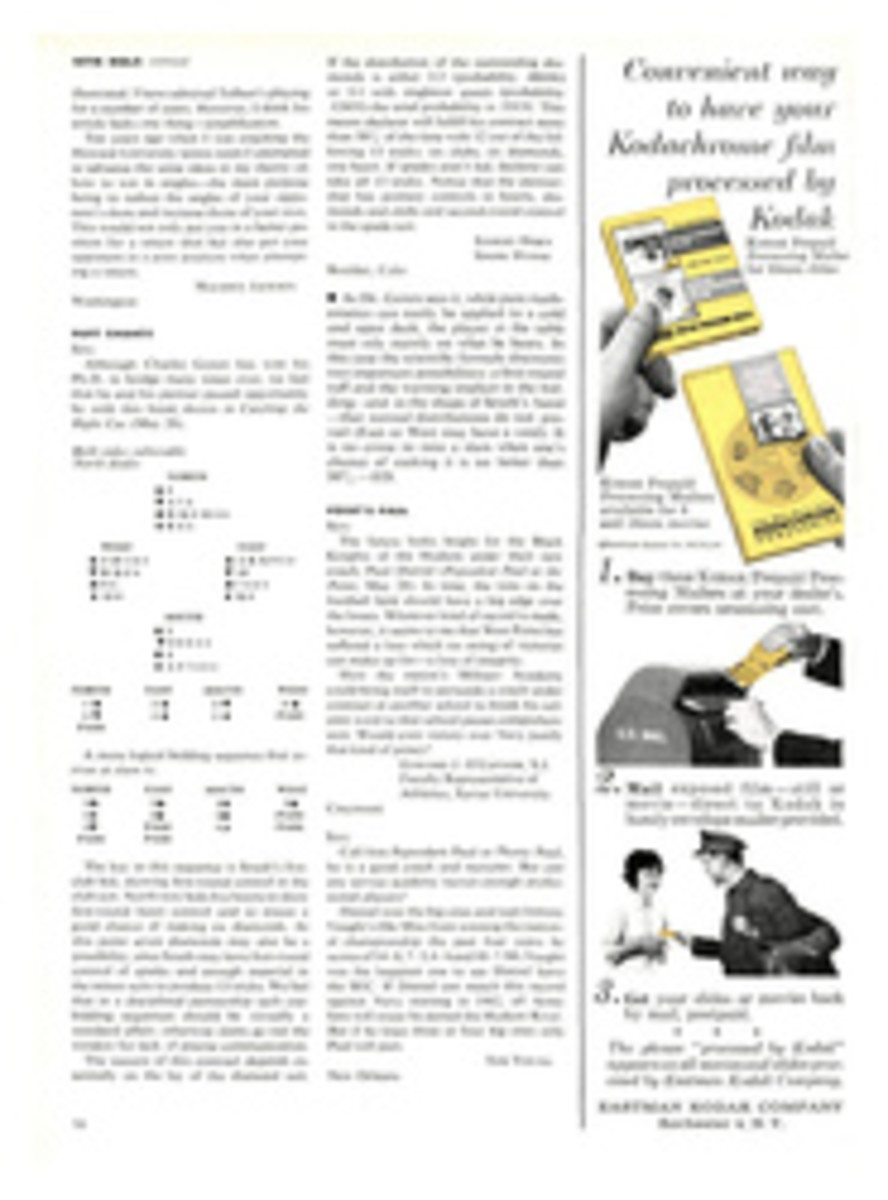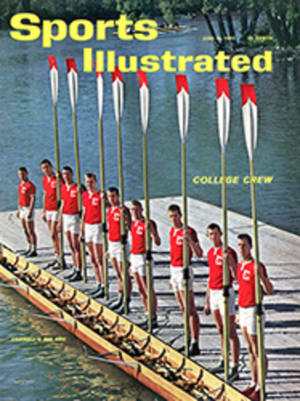
Bony pretender to the lofty throne of 'Finisterre'
As skeletons go, the curious marine vertebrate shown at left is an anatomical wonder. A steel pipe, which serves as its spinal column, runs from its steel nose bone all the way down to its steel pelvis; steel braces gird up the specimen's ribs, and an extension of the spinal column, also steel, even helps hold up its tail. The skeleton, with its metal bones here indicated in red, fits neatly inside the fiber-glass skin of Jack Powell's Paper Tiger (shown under sail in insert), and if osteologists are intrigued by this bony framework, so are the sailors on the 135 other yachts gathered at Newport, R.I. this week for the start of the 23rd Bermuda race.
Very few skeletons in the history of ocean racing have been talked about quite as much. This ingenious steel frame has been called with admiration the secret of Paper Tiger's remarkable ocean racing success. It has also been criticized as a designer's deliberate attempt to exploit loopholes in the Cruising Club of America's handicap rule to gain a low racing rating, thus earning for the boat the disparaging label: "a rule-beater." It has been the focal point of some wonderfully inaccurate speculation and, in the process, has ignited one of the hottest marine controversies of the past three years.
Had Paper Tiger been a slow boat, or had an unfavorable rating, no one would have made a sound, except perhaps to snicker at the folly of the young designer, Charlie Morgan of St. Petersburg, Fla., who dreamed up the idea of building a bag of bones. But Paper Tiger, with a ridiculously low handicap rating of 25.5, won the championship of the 1961 Southern Ocean Racing Conference in her very first season afloat. This brought on very few snickers. In fact, one opposing skipper was so frustrated by Paper Tiger's victory he refused to compete against the boat again till its rating was raised. When Powell sailed his boat to its second consecutive SORC championship last winter, leading so decisively he had only to finish 23rd in the last race to win, the skeleton was rattling loudly—and another yachtsman just gave up and retired from ocean racing altogether. Owner Powell was unimpressed by his critics. "I wonder what there is in the spirit or the letter of the rule," he said, "which is intended to prevent the building of boats that rate well."
Part of Paper Tiger's advantage under the then existing rule was the stability she got from the weight of the steel skeleton, together with that of her fuel and water tanks (in blue and black areas at left) and her engine and batteries, which fit under the sole of the main cabin. These all help keep her upright in a breeze; but they are neither as massive nor as wholly effective as the imagination of her rivals has made them. The backbone is not, as rumored, an I beam, but common 2½-inch plumbing pipe. The engine is not an immense machine sunk in a special blister deep in the skeletal innards; it is a small 30-hp Atomic Four, installed in a convenient spot just above the centerboard trunk. The hull is not reinforced with steel rods—or anything else. It is merely a thin skin of plain glass fibers and polyester, an inch at the gar-boards and ‚Öú inch at the sheers, and besides giving the boat form, its only real purpose is to keep the water out. Finally, the low-slung gas and water tanks, a point of suspicion in any successful ocean racer, have a combined capacity of just 120 gallons.
Despite their modest size, however, all these things were placed where they would do the most good—down low, to act as unpenalized ballast. Thus Paper Tiger did indeed take advantage of a loophole in the rule, and Designer Morgan, a man of refreshing candor in the cautious world of naval architecture, made no bones about it: "Sure, it's a rule-beater. I built it with that in mind. But it doesn't cheat the rule. If the rule has inequities, then go change the rule."
The C.C.A. promptly did so, changing the method of calculating a boat's stability and thus plugging at least partially a hole which gave Paper Tiger an advantage. Two months ago Paper Tiger was measured under the revised rule for the 635-mile race to Bermuda—the oldest, most revered open ocean event in American sailing. A new rating came back, 27.3, not as low as before but still low enough to give Paper Tiger a strong competitive position for her greatest test as an ocean racer.
Unfortunately, one element will be missing from the test. Carleton Mitchell has not entered his famous Finisterre in this year's race (see below for Mitchell's own story). But the designing trend his boat has established over the last seven years will be conspicuously present in Paper Tiger. Like Finisterre, Paper Tiger is a short, fat boat; to the eye it appears ungainly and slow, but it possesses a running speed that belies its beamy shape and 40-foot length. Like Finisterre, it is a center boarder with a driving power to windward that is the envy of many a larger keelboat. Both boats were built to cruise as well as race, yet both, because of their low ratings, provoked controversy leading to changes in the rule. This year, as its tough, tubby forebear did in 1956, Paper Tiger enters its first Bermuda race wearing the crown of the Southern Circuit.
There are, however, two essential differences. One is Paper Tiger's steel skeleton, which may start a trend to this kind of structure just as Finisterre once gave the main impetus toward center boarders. The primary advantage of the skeleton is this: when the stays and shrouds are tightened, the mast is thrust downward, placing strain on the hull. When the sails fill out, the strain increases. In Paper Tiger, however, that pressure is absorbed along the length of the pipe backbone, passed on through steel ribs to the plywood bulkheads and finally dispersed over the broad deck with its eight-inch crown. Meanwhile, the stays and shrouds, themselves anchored to the skeleton, stay uniformly taut, allowing the sails to retain the best aerodynamic shape.
The other difference between the two boats is pure status—Finisterre is the only three-time winner in the 56-year history of the big race; her successor has a long way to go. When this fact is pointed out, Morgan just smiles confidently and says, "We're picking up where Finisterre left off."
TWO PHOTOS

